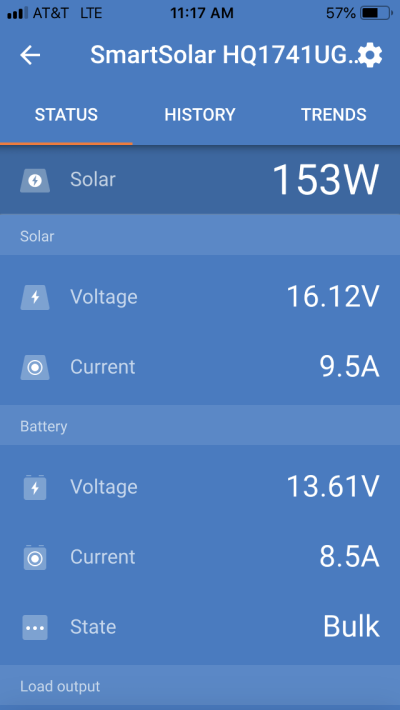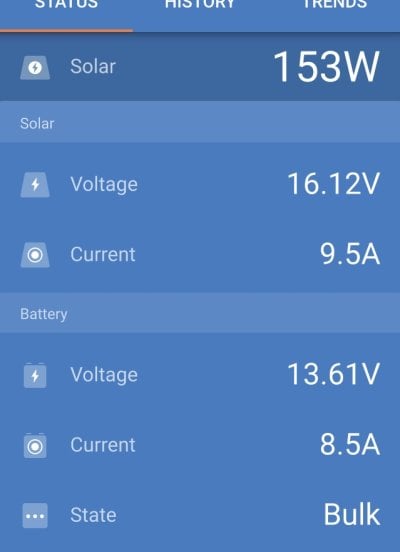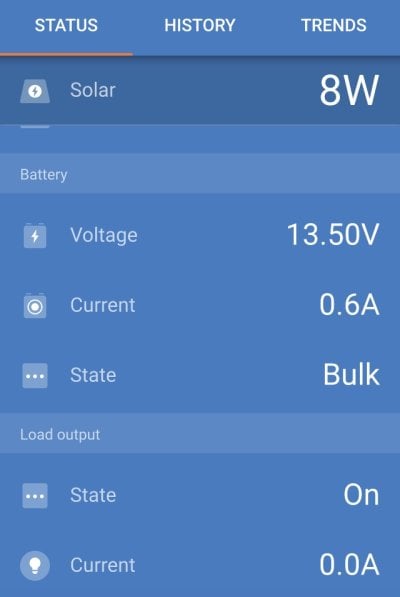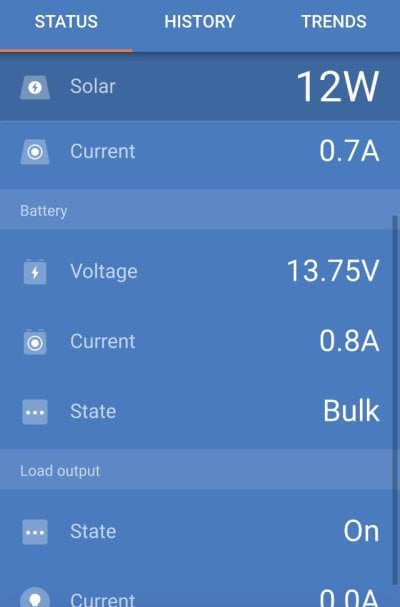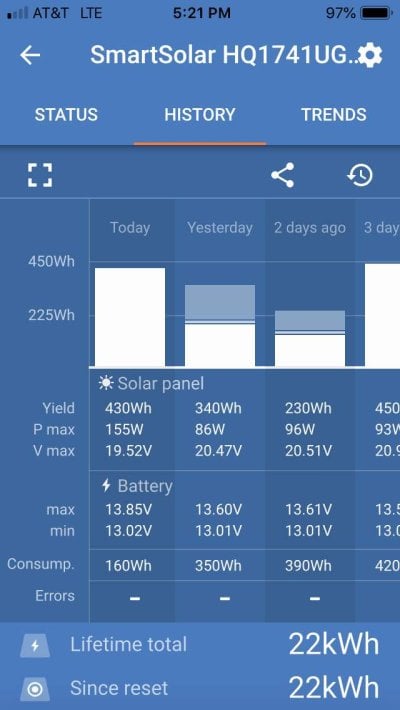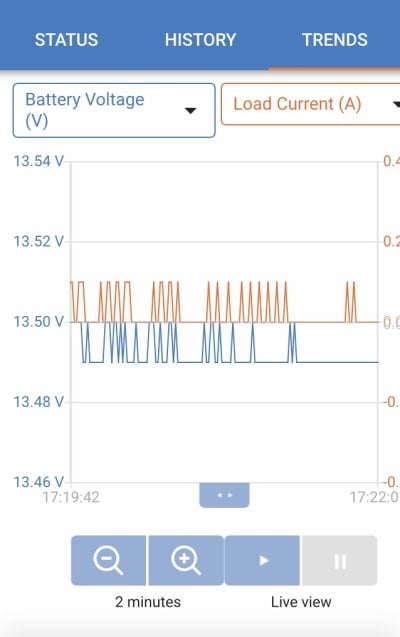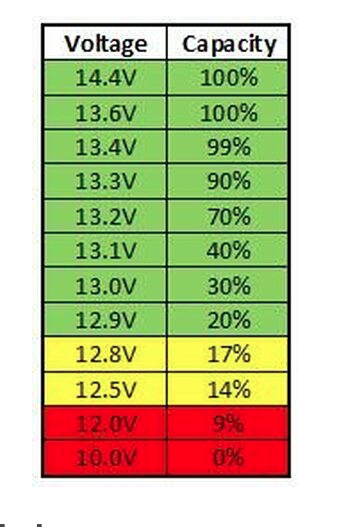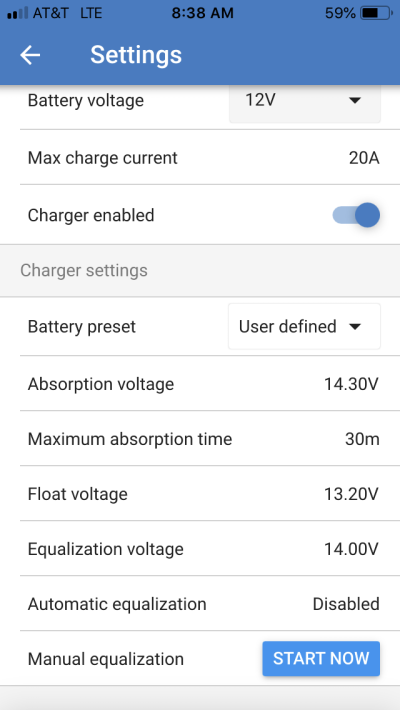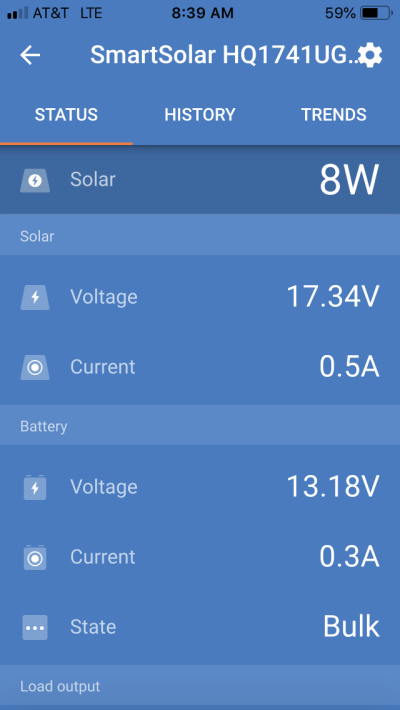You are using an out of date browser. It may not display this or other websites correctly.
You should upgrade or use an alternative browser.
You should upgrade or use an alternative browser.
LiFePo4 charging
- Thread starter buckland
- Start date
After 4 hours on the extra panel... an initial jump... the voltage settled back down at 13.5 (the Isotherm fridge draw no more than 3 amps when on). So I unplugged the extra panel and plugged in the shore power with the IQ4 (for LiFePo4 battery management Iota) and it started charging right off and I will leave it on for a few hours then unplug after checking the voltage. I took photos of the controller app page that monitors the ins and outs. For what it may be worth for those that know more than I maybe there is a pattern in there I do not see.
It's either the battery can't hold the charge over 13.5 or...... I'll describe when each photo was taken:
1st was when I plugged in extra solar panel
2nd when I plugged in the shore power
3rd after 10 minutes plugged in it fell back down to 13.5
4th a little History of the day
5th live goings on
It's either the battery can't hold the charge over 13.5 or...... I'll describe when each photo was taken:
1st was when I plugged in extra solar panel
2nd when I plugged in the shore power
3rd after 10 minutes plugged in it fell back down to 13.5
4th a little History of the day
5th live goings on
Attachments
What are you wanting to see? A higher resting voltage? 13.5 is what Victron/Battleborn recommend for a float voltage, and your charger is still going strong by putting 8.5A into the batteries at that voltage. That's good, no?
Well I was expecting the battery to charge up to 13.8 or 14. V. Even with everything off in camper and the Shore power plugged in it won't charge (and hold it) higher than 13.45
I was looking at the LiFePo4 charge chart and it seemed like that a higher charge was normal.
I was looking at the LiFePo4 charge chart and it seemed like that a higher charge was normal.
Attachments
This may help. Screen shots from my rig this morning


97% on the Victron BMV = 13.55 V


97% on the Victron BMV = 13.55 V
Thanks for taking the time Vic. That is what I want to see in the AM too but mine is 13.1 V (just the fridge on all night) If I charge all day solar or if I plug in shore for 5 hours I will get up to 13.56 V (when the fridge is not running). That is about as high as it goes but not for long. I (tho this is only a gut feeling) think I have ...out of the 120 cells in packs of 30, have a few weak cells that have limited the pack. If that is all that it is I can live with it. I still have the empty battery box from having 2 AGM batteries. Maybe next season... when I hope to do a coupe longer trips... I'll spring for a Battleborn and have both in there.... still lighter than 2 AGM.
From the first picture - 13.61V @8.5A, it looks like you have your absorption voltage on the charge controller set to 13.6v (there is more solar power available, but the charge controller is choosing not to use it). In which case the solar is doing what it should, get the battery up to 13.6V and hold it there for what ever your absorption time is.
If you want the solar voltage to go higher than this, then you need to raise your absorption voltage in the charge controller settings. That being said, if you get the battery up to 13.6V, then you are at 90% + state of charge, so you should be fine.
If you want the solar voltage to go higher than this, then you need to raise your absorption voltage in the charge controller settings. That being said, if you get the battery up to 13.6V, then you are at 90% + state of charge, so you should be fine.
rando, can you revisit how you set your BMV and MPPT controller to self-limit charging to 90% or so?rando said:From the first picture - 13.61V @8.5A, it looks like you have your absorption voltage on the charge controller set to 13.6v (there is more solar power available, but the charge controller is choosing not to use it). In which case the solar is doing what it should, get the battery up to 13.6V and hold it there for what ever your absorption time is.
If you want the solar voltage to go higher than this, then you need to raise your absorption voltage in the charge controller settings. That being said, if you get the battery up to 13.6V, then you are at 90% + state of charge, so you should be fine.
As another reference point (post #16) my absorption is set to 14.4. Both my batteries (in parallel) float @99% capacity when full. This has been what is shown as “fully charged” as displayed by the internal Bluetooth module in each Batterry. On 08/22/19 the resting V was 13.48. On another post 07/27/19 it was 13.45. I have not documented V during charging. My memory is ... charging does reach 100% with a higher V & then settles @99% with a lower V.
I have a question regarding my post #16. When my Batteries were inadvertently & completely drained, why did they abnormally, initially, charge so slowly? (There may have been extenuating factors) Is this typical of LFP4? Would charging accelerate, as the V began to increase, closer to its full capacity? My usage so far, except for this once, has been ~15-18%/night. I have always been impressed how efficient the charging has been typically. Why so seemingly slow when drained? It causes some off grid concerns. Excuse my lack of electrical know how.
I have a question regarding my post #16. When my Batteries were inadvertently & completely drained, why did they abnormally, initially, charge so slowly? (There may have been extenuating factors) Is this typical of LFP4? Would charging accelerate, as the V began to increase, closer to its full capacity? My usage so far, except for this once, has been ~15-18%/night. I have always been impressed how efficient the charging has been typically. Why so seemingly slow when drained? It causes some off grid concerns. Excuse my lack of electrical know how.
Thanks Lars. I had changed the absorption to 14.3 as seen below and the time at 30 minutes. I think I will increase the time to an hour. (kinda feels like I'm just jiggling the butterfly valve on the old chevy... see what happens!)
Attached the settings and the monitor this AM... Voltage still only 13.2
Attached the settings and the monitor this AM... Voltage still only 13.2
Attachments
It is not that precise - when the camper is parked for a while, I set the absorption voltage to 13.5, absorption time to 10 minutes and float to 13.2V. Based on these measurements from powerstream and my experience 13.5V (3.375V per cell) should get the battery to somewhere around 80 - 90% SOC. This seems to be a better place to store the battery than 100% SOC.Vic Harder said:rando, can you revisit how you set your BMV and MPPT controller to self-limit charging to 90% or so?
When we are using the camper, I up the absorption voltage to 13.8V, which based on the above measurements should get the battery to 99% SOC. There is almost no advantage to going over 13.6V - 13.8V, taking the battery higher just increases the likely hood of unbalancing the cells,
13.2V is the normal resting voltage of fully LiFePO4 battery, so that is what I would expect to see first thing in the morning.buckland said:Thanks Lars. I had changed the absorption to 14.3 as seen below and the time at 30 minutes. I think I will increase the time to an hour. (kinda feels like I'm just jiggling the butterfly valve on the old chevy... see what happens!)
Attached the settings and the monitor this AM... Voltage still only 13.2
I don't really think there is any advantage in setting the absorption that high (see my last post), but if you want to see higher numbers is won't really hurt. I would also raise your float to 13.3 or 13.4V. Lithium batteries don't really want to float charge, but you do want the float voltage to be enough that any loads that come on during the day are drawing from the solar panel, not the battery.
OK, that's some interesting research. I wonder why Battleborn recommends that the absorb voltage be set to 14.4V (see post #2 in this thread). I recall something I read on their site which indicated using a 30 min/100AH Absorb phase actually helped with balancing the cells.rando said:When we are using the camper, I up the absorption voltage to 13.8V, which based on the above measurements should get the battery to 99% SOC. There is almost no advantage to going over 13.6V - 13.8V, taking the battery higher just increases the likely hood of unbalancing the cells,
Many of the off the shelf battery management systems use what is called 'top balancing' to actively balance the cells. Once the individual cells get above 3.6V (14.4V total) the BMS connect resistors to the high cells to bleed them down to match the lower cells. I am guessing that is why Battleborn wants you to get the voltage so high, so their internal BMS can top balance the cells.
My BMS also has this feature, but because I never charge my battery that high, I just manually run an equalization cycle using a battery balancer every 6 months or so if the cells need it.
My BMS also has this feature, but because I never charge my battery that high, I just manually run an equalization cycle using a battery balancer every 6 months or so if the cells need it.
StarkPower also recommended absorption V set to 14.4V & float set to 13.8. Top balancing as a term makes sense. I never considered any different setting but it makes sense based on active use vs non use. I am fine with my float V set for now.
My max absorption time is set for 6 hours. Is this excessive, ie “not a good idea”? Would also appreciate any comments, on my query, concerning the expected charging parameters one would experience with a drained Battery vs “topping” a mostly charged Battery. Thanks.
My max absorption time is set for 6 hours. Is this excessive, ie “not a good idea”? Would also appreciate any comments, on my query, concerning the expected charging parameters one would experience with a drained Battery vs “topping” a mostly charged Battery. Thanks.
The 'drop in lithium' battery assemblers face a little bit of a conundrum - their sales model is to offer a LiFePO4 battery that can approximate the characteristics of a lead acid battery and play reasonably well with existing lead acid charging infrastructure. As such they need to publish specs that fit within the range of most lead acid battery chargers. However the chemistry of LiFePO4 is completely different than lead-acid and while it will work at the listed specifications, they are not optimum.
Low charging voltages lead to longer cycle life. While there is much more data for lithium-cobalt (aka lithium ion) than for LiFePO4, given the similarity in the chemistry it is not unreasonable to assume the relationship between charge voltage and cycle life is similar for both chemistries. The rule of thumb for lithium is that for every 0.1V you reduce the charge voltage you double the cycle life. I have no idea if this relationship holds for LiFePO4, but I am sure there is a similar relationship.
There is also a clear relationship between state of charge during storage and calendar life - after 1 year of storage at 100% SOC an LiFePO4 battery will irrecoverably loose 20% of its capacity, whereas one stored at 40% SOC would only loose 4% of its capacity. Let your expensive lithium battery sit at 100% SOC is probably unwise.
Any I am rambling - to summarize, yes you can charge your battery to 14.4V and float it at 13.8V, but it will last longer if you charge it 13.8V and float at 13.2V or not at all. It is very likely that your battery will last long enough in either case, but if you have a choice, pick the lower numbers.
Low charging voltages lead to longer cycle life. While there is much more data for lithium-cobalt (aka lithium ion) than for LiFePO4, given the similarity in the chemistry it is not unreasonable to assume the relationship between charge voltage and cycle life is similar for both chemistries. The rule of thumb for lithium is that for every 0.1V you reduce the charge voltage you double the cycle life. I have no idea if this relationship holds for LiFePO4, but I am sure there is a similar relationship.
There is also a clear relationship between state of charge during storage and calendar life - after 1 year of storage at 100% SOC an LiFePO4 battery will irrecoverably loose 20% of its capacity, whereas one stored at 40% SOC would only loose 4% of its capacity. Let your expensive lithium battery sit at 100% SOC is probably unwise.
Any I am rambling - to summarize, yes you can charge your battery to 14.4V and float it at 13.8V, but it will last longer if you charge it 13.8V and float at 13.2V or not at all. It is very likely that your battery will last long enough in either case, but if you have a choice, pick the lower numbers.
Thanks for the "ramble" rando. Very helpful explanation!
Just tested the lower settings rando. Interesting. Battery was fully charged and at 13.4v. So when I set float to 13.2 the BMV showed the battery discharging. Loads would have been the fridge and the truck battery. The solar controller was not providing the power even though the camper was in full sun because float was at 13.2.
I bumped up the float setting to 13.4 for now, so now the solar panels are taking all the load during the day once the batteries are fully charged. I guess the whole point here is to NOT fully charge them, right?
I bumped up the float setting to 13.4 for now, so now the solar panels are taking all the load during the day once the batteries are fully charged. I guess the whole point here is to NOT fully charge them, right?
ckent323
Senior Member
For folks dealing with chronically partially charged batteries for extended periods I have read some encouraging information about the Lead/Carbon Foam batteries (Firefly Oasis).
I am still learning about these and finding independent data to back up the claims requires searching.
Price seems to be between high quality AGM and LiFePO4 (i.e. $400 - $500 for 12V 100ah). Apparently the marine boating community has been using them (based on my Dad's boat I understand the challenge of keeping a battery fully topped off so these are appealing for those who want to operate between 30% and 80% soc.
More info here:
https://oceanplanetenergy.com/advanced-energy-storage-systems/firefly-energys-oasis-group-31/
From Battery University Site:
Firefly Energy
The composite plate material of the Firefly Energy battery is based on a lead-acid variant, and the maker claims that the battery is lighter, longer living and offers a higher active material utilization than current lead acid systems. It is also one of the few lead acid batteries that can operate for extended time in partial-states-of-charge. The battery includes carbon-foam electrodes for the negative plates, which gives it a performance that is comparable to NiMH but at lower manufacturing costs. Firefly Energy was a spin-off of Caterpillar, and in 2010 it went into bankruptcy. The company was later revived under separate ownership but folded again. Since 2014, the battery is manufactured in India under Firefly Batteries Pvt. Ltd."
Perhaps this should be the start of a separate topic so I will start one here:
http://www.wanderthewest.com/forum/topic/18810-advanced-lead-carbon-batteries-aka-firefly-oasis/
Regards,
Craig
I am still learning about these and finding independent data to back up the claims requires searching.
Price seems to be between high quality AGM and LiFePO4 (i.e. $400 - $500 for 12V 100ah). Apparently the marine boating community has been using them (based on my Dad's boat I understand the challenge of keeping a battery fully topped off so these are appealing for those who want to operate between 30% and 80% soc.
More info here:
https://oceanplanetenergy.com/advanced-energy-storage-systems/firefly-energys-oasis-group-31/
From Battery University Site:
Firefly Energy
The composite plate material of the Firefly Energy battery is based on a lead-acid variant, and the maker claims that the battery is lighter, longer living and offers a higher active material utilization than current lead acid systems. It is also one of the few lead acid batteries that can operate for extended time in partial-states-of-charge. The battery includes carbon-foam electrodes for the negative plates, which gives it a performance that is comparable to NiMH but at lower manufacturing costs. Firefly Energy was a spin-off of Caterpillar, and in 2010 it went into bankruptcy. The company was later revived under separate ownership but folded again. Since 2014, the battery is manufactured in India under Firefly Batteries Pvt. Ltd."
Perhaps this should be the start of a separate topic so I will start one here:
http://www.wanderthewest.com/forum/topic/18810-advanced-lead-carbon-batteries-aka-firefly-oasis/
Regards,
Craig
This is interesting Vic I had the same thing happen. Even though the panels were in full sun I was drawing half the load off battery. I will bump up the float to 13.4 just for a look see. I did buy a temperature smart sensor from Victron and attached it to my setup (a bit tricky as the sensor has to stick to one paper covered cell). It is blue tooth to Victron app.
Similar threads - WTW
- Openroad
- Electrical, Charging, Solar, Batteries and Generat
- Replies: 4
- Views: 315
- buckland
- Electrical, Charging, Solar, Batteries and Generat
- Replies: 3
- Views: 388
- tex85
- Electrical, Charging, Solar, Batteries and Generat
- Replies: 2
- Views: 247
- Sagefemme
- Electrical, Charging, Solar, Batteries and Generat
- Replies: 4
- Views: 347

